Decision-Making in Management: Simon's Quote and Real-World Scenarios
VerifiedAdded on 2020/03/28
|17
|4285
|150
Essay
AI Summary
This essay delves into the critical aspects of decision-making within a managerial context, anchored by Herbert Simon's quote on the limitations of human rationality. The essay dissects key concepts such as bounded rationality, system 1 and system 2 thinking, and the processes of judgment and decision-making, illustrating their interconnectedness and impact on workplace dynamics. It explores how these elements influence an individual's capacity to make rational choices, particularly under pressure and in complex situations. The essay then uses real-life workplace scenarios to demonstrate the practical application of these concepts, thereby enhancing the understanding of how managers navigate the challenges of decision-making and maintain a balance between personal and professional considerations. The analysis emphasizes the importance of rational thinking, consistent evaluation, and conscious approaches to overcome cognitive limitations, thereby fostering improved judgment and effective leadership.
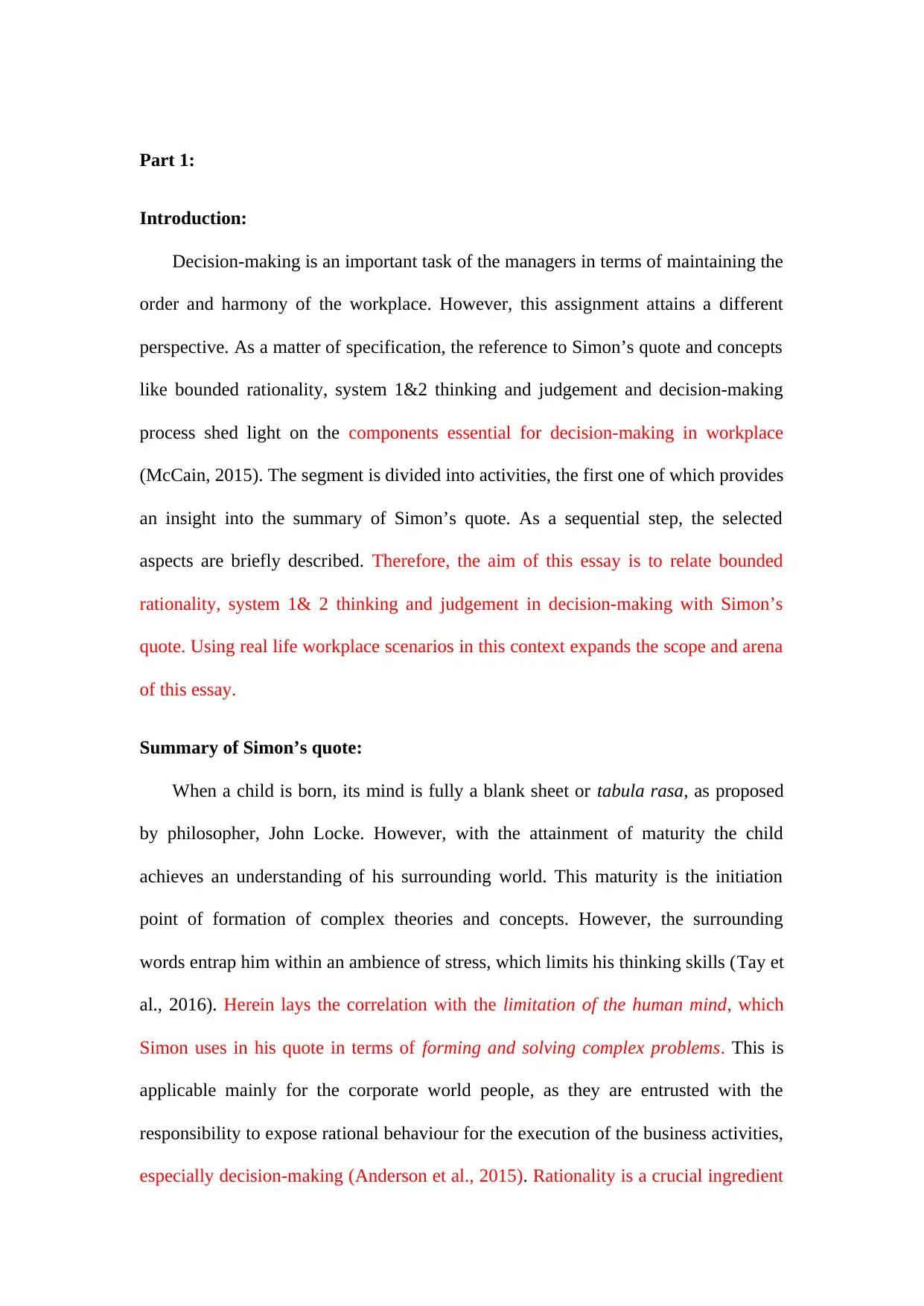
Part 1:
Introduction:
Decision-making is an important task of the managers in terms of maintaining the
order and harmony of the workplace. However, this assignment attains a different
perspective. As a matter of specification, the reference to Simon’s quote and concepts
like bounded rationality, system 1&2 thinking and judgement and decision-making
process shed light on the components essential for decision-making in workplace
(McCain, 2015). The segment is divided into activities, the first one of which provides
an insight into the summary of Simon’s quote. As a sequential step, the selected
aspects are briefly described. Therefore, the aim of this essay is to relate bounded
rationality, system 1& 2 thinking and judgement in decision-making with Simon’s
quote. Using real life workplace scenarios in this context expands the scope and arena
of this essay.
Summary of Simon’s quote:
When a child is born, its mind is fully a blank sheet or tabula rasa, as proposed
by philosopher, John Locke. However, with the attainment of maturity the child
achieves an understanding of his surrounding world. This maturity is the initiation
point of formation of complex theories and concepts. However, the surrounding
words entrap him within an ambience of stress, which limits his thinking skills (Tay et
al., 2016). Herein lays the correlation with the limitation of the human mind, which
Simon uses in his quote in terms of forming and solving complex problems. This is
applicable mainly for the corporate world people, as they are entrusted with the
responsibility to expose rational behaviour for the execution of the business activities,
especially decision-making (Anderson et al., 2015). Rationality is a crucial ingredient
Introduction:
Decision-making is an important task of the managers in terms of maintaining the
order and harmony of the workplace. However, this assignment attains a different
perspective. As a matter of specification, the reference to Simon’s quote and concepts
like bounded rationality, system 1&2 thinking and judgement and decision-making
process shed light on the components essential for decision-making in workplace
(McCain, 2015). The segment is divided into activities, the first one of which provides
an insight into the summary of Simon’s quote. As a sequential step, the selected
aspects are briefly described. Therefore, the aim of this essay is to relate bounded
rationality, system 1& 2 thinking and judgement in decision-making with Simon’s
quote. Using real life workplace scenarios in this context expands the scope and arena
of this essay.
Summary of Simon’s quote:
When a child is born, its mind is fully a blank sheet or tabula rasa, as proposed
by philosopher, John Locke. However, with the attainment of maturity the child
achieves an understanding of his surrounding world. This maturity is the initiation
point of formation of complex theories and concepts. However, the surrounding
words entrap him within an ambience of stress, which limits his thinking skills (Tay et
al., 2016). Herein lays the correlation with the limitation of the human mind, which
Simon uses in his quote in terms of forming and solving complex problems. This is
applicable mainly for the corporate world people, as they are entrusted with the
responsibility to expose rational behaviour for the execution of the business activities,
especially decision-making (Anderson et al., 2015). Rationality is a crucial ingredient
Paraphrase This Document
Need a fresh take? Get an instant paraphrase of this document with our AI Paraphraser
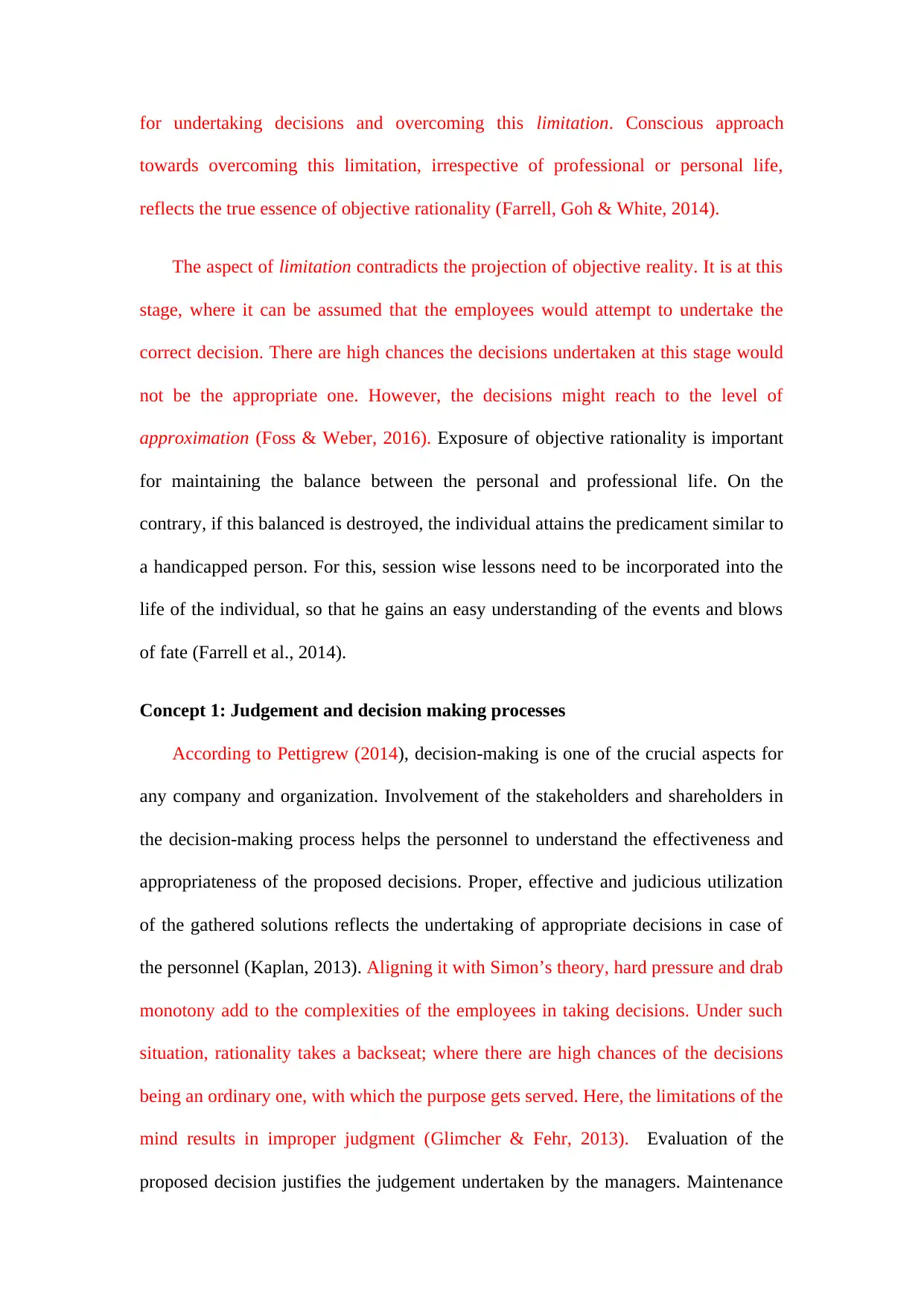
for undertaking decisions and overcoming this limitation. Conscious approach
towards overcoming this limitation, irrespective of professional or personal life,
reflects the true essence of objective rationality (Farrell, Goh & White, 2014).
The aspect of limitation contradicts the projection of objective reality. It is at this
stage, where it can be assumed that the employees would attempt to undertake the
correct decision. There are high chances the decisions undertaken at this stage would
not be the appropriate one. However, the decisions might reach to the level of
approximation (Foss & Weber, 2016). Exposure of objective rationality is important
for maintaining the balance between the personal and professional life. On the
contrary, if this balanced is destroyed, the individual attains the predicament similar to
a handicapped person. For this, session wise lessons need to be incorporated into the
life of the individual, so that he gains an easy understanding of the events and blows
of fate (Farrell et al., 2014).
Concept 1: Judgement and decision making processes
According to Pettigrew (2014), decision-making is one of the crucial aspects for
any company and organization. Involvement of the stakeholders and shareholders in
the decision-making process helps the personnel to understand the effectiveness and
appropriateness of the proposed decisions. Proper, effective and judicious utilization
of the gathered solutions reflects the undertaking of appropriate decisions in case of
the personnel (Kaplan, 2013). Aligning it with Simon’s theory, hard pressure and drab
monotony add to the complexities of the employees in taking decisions. Under such
situation, rationality takes a backseat; where there are high chances of the decisions
being an ordinary one, with which the purpose gets served. Here, the limitations of the
mind results in improper judgment (Glimcher & Fehr, 2013). Evaluation of the
proposed decision justifies the judgement undertaken by the managers. Maintenance
towards overcoming this limitation, irrespective of professional or personal life,
reflects the true essence of objective rationality (Farrell, Goh & White, 2014).
The aspect of limitation contradicts the projection of objective reality. It is at this
stage, where it can be assumed that the employees would attempt to undertake the
correct decision. There are high chances the decisions undertaken at this stage would
not be the appropriate one. However, the decisions might reach to the level of
approximation (Foss & Weber, 2016). Exposure of objective rationality is important
for maintaining the balance between the personal and professional life. On the
contrary, if this balanced is destroyed, the individual attains the predicament similar to
a handicapped person. For this, session wise lessons need to be incorporated into the
life of the individual, so that he gains an easy understanding of the events and blows
of fate (Farrell et al., 2014).
Concept 1: Judgement and decision making processes
According to Pettigrew (2014), decision-making is one of the crucial aspects for
any company and organization. Involvement of the stakeholders and shareholders in
the decision-making process helps the personnel to understand the effectiveness and
appropriateness of the proposed decisions. Proper, effective and judicious utilization
of the gathered solutions reflects the undertaking of appropriate decisions in case of
the personnel (Kaplan, 2013). Aligning it with Simon’s theory, hard pressure and drab
monotony add to the complexities of the employees in taking decisions. Under such
situation, rationality takes a backseat; where there are high chances of the decisions
being an ordinary one, with which the purpose gets served. Here, the limitations of the
mind results in improper judgment (Glimcher & Fehr, 2013). Evaluation of the
proposed decision justifies the judgement undertaken by the managers. Maintenance
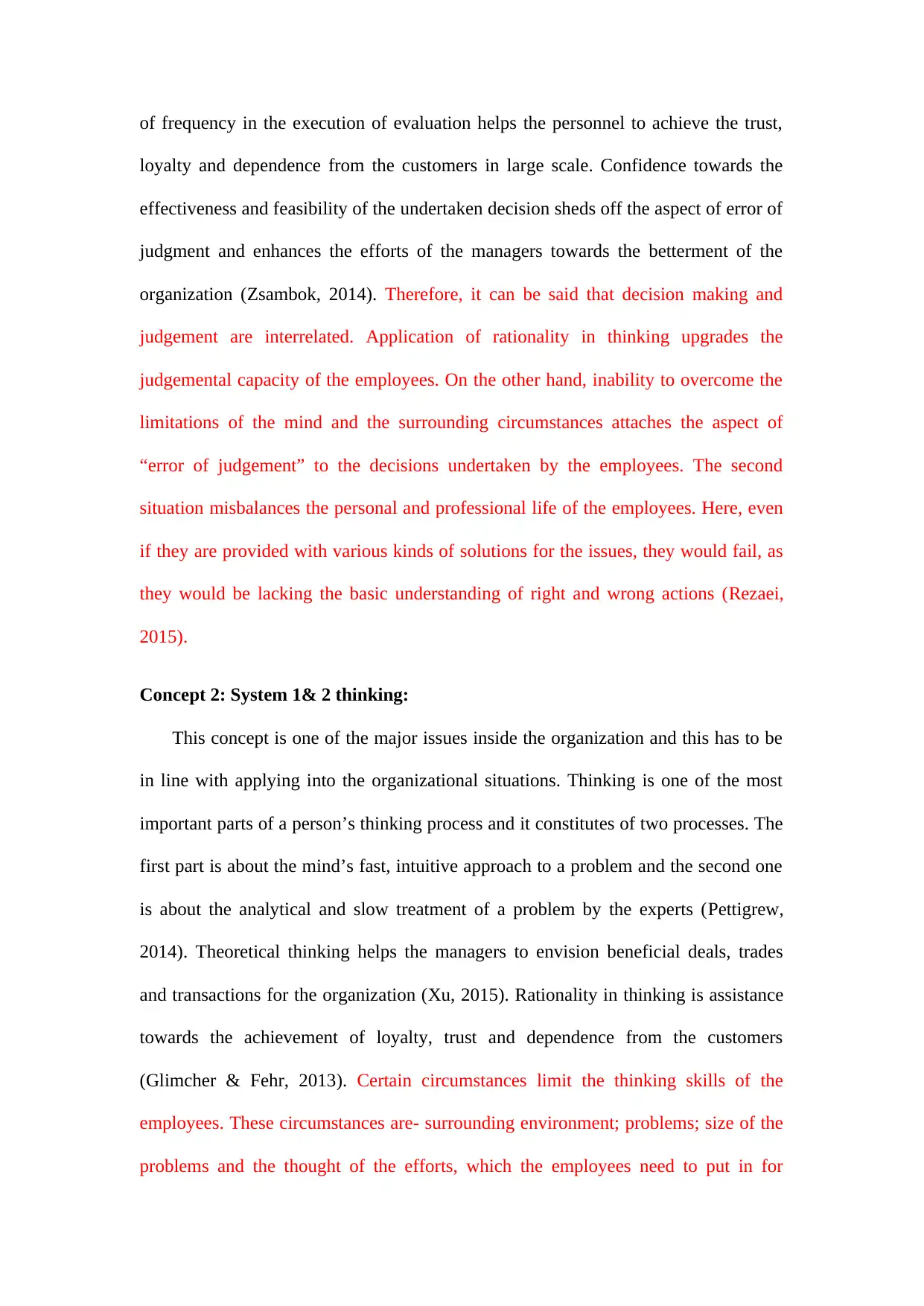
of frequency in the execution of evaluation helps the personnel to achieve the trust,
loyalty and dependence from the customers in large scale. Confidence towards the
effectiveness and feasibility of the undertaken decision sheds off the aspect of error of
judgment and enhances the efforts of the managers towards the betterment of the
organization (Zsambok, 2014). Therefore, it can be said that decision making and
judgement are interrelated. Application of rationality in thinking upgrades the
judgemental capacity of the employees. On the other hand, inability to overcome the
limitations of the mind and the surrounding circumstances attaches the aspect of
“error of judgement” to the decisions undertaken by the employees. The second
situation misbalances the personal and professional life of the employees. Here, even
if they are provided with various kinds of solutions for the issues, they would fail, as
they would be lacking the basic understanding of right and wrong actions (Rezaei,
2015).
Concept 2: System 1& 2 thinking:
This concept is one of the major issues inside the organization and this has to be
in line with applying into the organizational situations. Thinking is one of the most
important parts of a person’s thinking process and it constitutes of two processes. The
first part is about the mind’s fast, intuitive approach to a problem and the second one
is about the analytical and slow treatment of a problem by the experts (Pettigrew,
2014). Theoretical thinking helps the managers to envision beneficial deals, trades
and transactions for the organization (Xu, 2015). Rationality in thinking is assistance
towards the achievement of loyalty, trust and dependence from the customers
(Glimcher & Fehr, 2013). Certain circumstances limit the thinking skills of the
employees. These circumstances are- surrounding environment; problems; size of the
problems and the thought of the efforts, which the employees need to put in for
loyalty and dependence from the customers in large scale. Confidence towards the
effectiveness and feasibility of the undertaken decision sheds off the aspect of error of
judgment and enhances the efforts of the managers towards the betterment of the
organization (Zsambok, 2014). Therefore, it can be said that decision making and
judgement are interrelated. Application of rationality in thinking upgrades the
judgemental capacity of the employees. On the other hand, inability to overcome the
limitations of the mind and the surrounding circumstances attaches the aspect of
“error of judgement” to the decisions undertaken by the employees. The second
situation misbalances the personal and professional life of the employees. Here, even
if they are provided with various kinds of solutions for the issues, they would fail, as
they would be lacking the basic understanding of right and wrong actions (Rezaei,
2015).
Concept 2: System 1& 2 thinking:
This concept is one of the major issues inside the organization and this has to be
in line with applying into the organizational situations. Thinking is one of the most
important parts of a person’s thinking process and it constitutes of two processes. The
first part is about the mind’s fast, intuitive approach to a problem and the second one
is about the analytical and slow treatment of a problem by the experts (Pettigrew,
2014). Theoretical thinking helps the managers to envision beneficial deals, trades
and transactions for the organization (Xu, 2015). Rationality in thinking is assistance
towards the achievement of loyalty, trust and dependence from the customers
(Glimcher & Fehr, 2013). Certain circumstances limit the thinking skills of the
employees. These circumstances are- surrounding environment; problems; size of the
problems and the thought of the efforts, which the employees need to put in for
⊘ This is a preview!⊘
Do you want full access?
Subscribe today to unlock all pages.

Trusted by 1+ million students worldwide
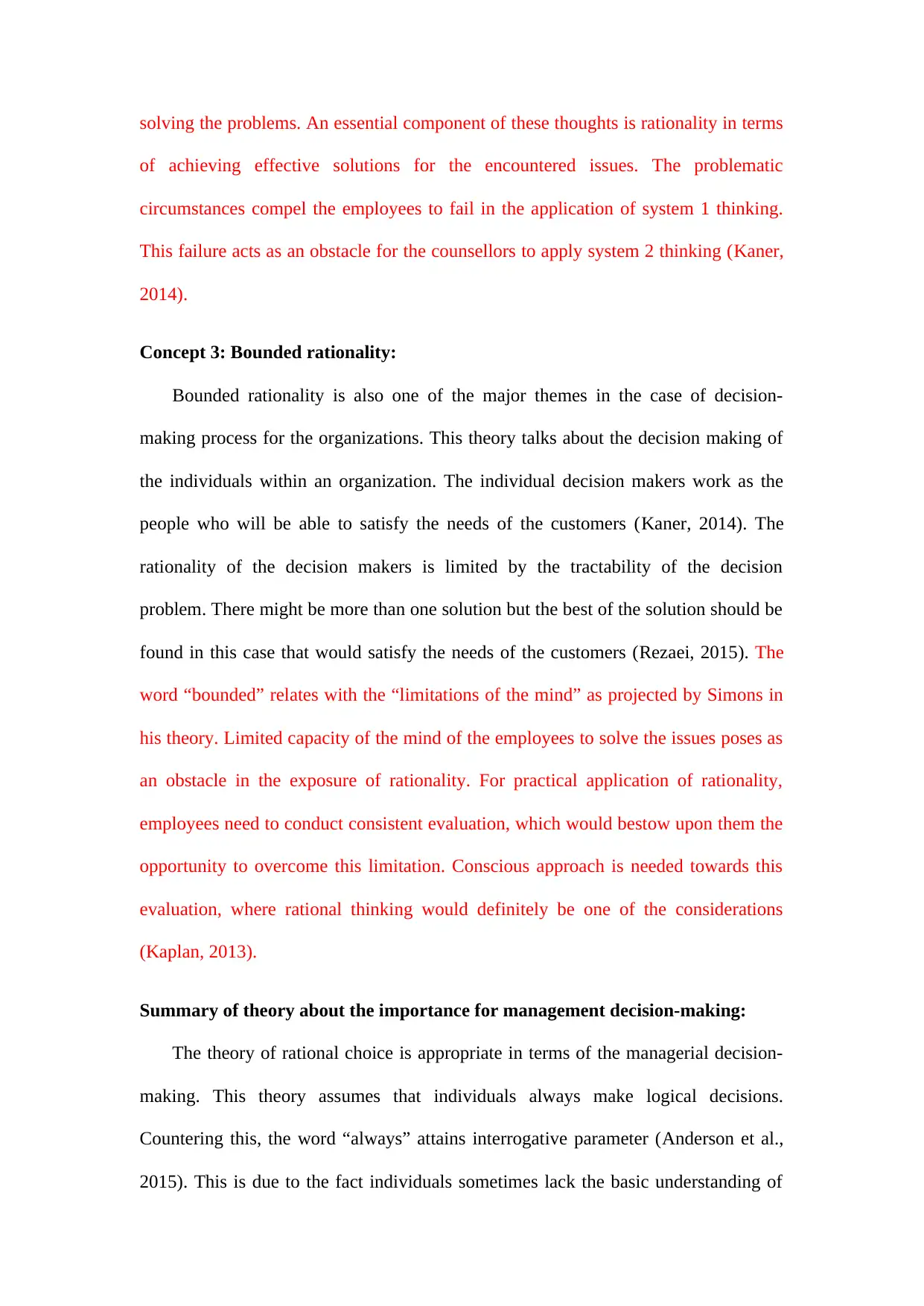
solving the problems. An essential component of these thoughts is rationality in terms
of achieving effective solutions for the encountered issues. The problematic
circumstances compel the employees to fail in the application of system 1 thinking.
This failure acts as an obstacle for the counsellors to apply system 2 thinking (Kaner,
2014).
Concept 3: Bounded rationality:
Bounded rationality is also one of the major themes in the case of decision-
making process for the organizations. This theory talks about the decision making of
the individuals within an organization. The individual decision makers work as the
people who will be able to satisfy the needs of the customers (Kaner, 2014). The
rationality of the decision makers is limited by the tractability of the decision
problem. There might be more than one solution but the best of the solution should be
found in this case that would satisfy the needs of the customers (Rezaei, 2015). The
word “bounded” relates with the “limitations of the mind” as projected by Simons in
his theory. Limited capacity of the mind of the employees to solve the issues poses as
an obstacle in the exposure of rationality. For practical application of rationality,
employees need to conduct consistent evaluation, which would bestow upon them the
opportunity to overcome this limitation. Conscious approach is needed towards this
evaluation, where rational thinking would definitely be one of the considerations
(Kaplan, 2013).
Summary of theory about the importance for management decision-making:
The theory of rational choice is appropriate in terms of the managerial decision-
making. This theory assumes that individuals always make logical decisions.
Countering this, the word “always” attains interrogative parameter (Anderson et al.,
2015). This is due to the fact individuals sometimes lack the basic understanding of
of achieving effective solutions for the encountered issues. The problematic
circumstances compel the employees to fail in the application of system 1 thinking.
This failure acts as an obstacle for the counsellors to apply system 2 thinking (Kaner,
2014).
Concept 3: Bounded rationality:
Bounded rationality is also one of the major themes in the case of decision-
making process for the organizations. This theory talks about the decision making of
the individuals within an organization. The individual decision makers work as the
people who will be able to satisfy the needs of the customers (Kaner, 2014). The
rationality of the decision makers is limited by the tractability of the decision
problem. There might be more than one solution but the best of the solution should be
found in this case that would satisfy the needs of the customers (Rezaei, 2015). The
word “bounded” relates with the “limitations of the mind” as projected by Simons in
his theory. Limited capacity of the mind of the employees to solve the issues poses as
an obstacle in the exposure of rationality. For practical application of rationality,
employees need to conduct consistent evaluation, which would bestow upon them the
opportunity to overcome this limitation. Conscious approach is needed towards this
evaluation, where rational thinking would definitely be one of the considerations
(Kaplan, 2013).
Summary of theory about the importance for management decision-making:
The theory of rational choice is appropriate in terms of the managerial decision-
making. This theory assumes that individuals always make logical decisions.
Countering this, the word “always” attains interrogative parameter (Anderson et al.,
2015). This is due to the fact individuals sometimes lack the basic understanding of
Paraphrase This Document
Need a fresh take? Get an instant paraphrase of this document with our AI Paraphraser
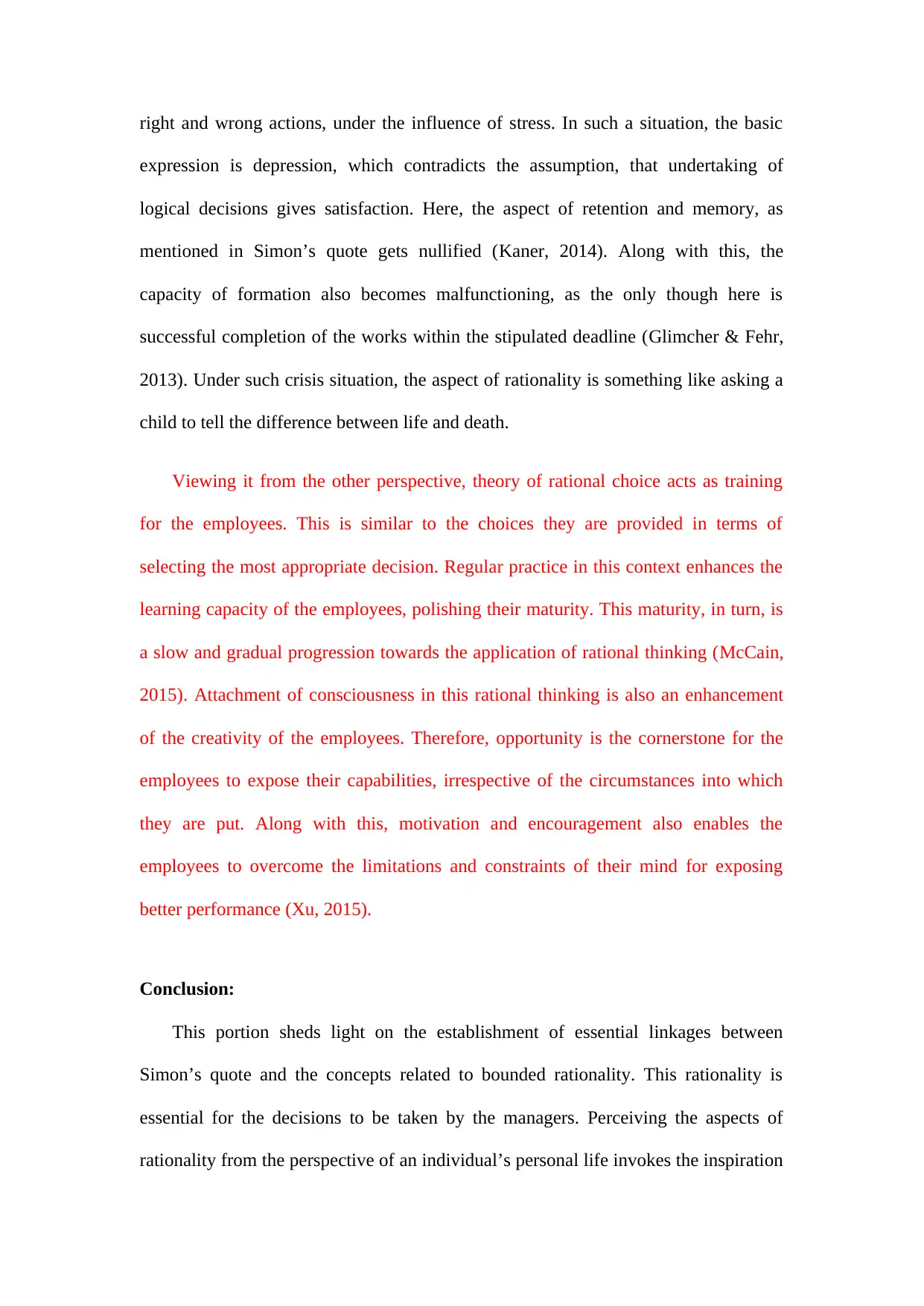
right and wrong actions, under the influence of stress. In such a situation, the basic
expression is depression, which contradicts the assumption, that undertaking of
logical decisions gives satisfaction. Here, the aspect of retention and memory, as
mentioned in Simon’s quote gets nullified (Kaner, 2014). Along with this, the
capacity of formation also becomes malfunctioning, as the only though here is
successful completion of the works within the stipulated deadline (Glimcher & Fehr,
2013). Under such crisis situation, the aspect of rationality is something like asking a
child to tell the difference between life and death.
Viewing it from the other perspective, theory of rational choice acts as training
for the employees. This is similar to the choices they are provided in terms of
selecting the most appropriate decision. Regular practice in this context enhances the
learning capacity of the employees, polishing their maturity. This maturity, in turn, is
a slow and gradual progression towards the application of rational thinking (McCain,
2015). Attachment of consciousness in this rational thinking is also an enhancement
of the creativity of the employees. Therefore, opportunity is the cornerstone for the
employees to expose their capabilities, irrespective of the circumstances into which
they are put. Along with this, motivation and encouragement also enables the
employees to overcome the limitations and constraints of their mind for exposing
better performance (Xu, 2015).
Conclusion:
This portion sheds light on the establishment of essential linkages between
Simon’s quote and the concepts related to bounded rationality. This rationality is
essential for the decisions to be taken by the managers. Perceiving the aspects of
rationality from the perspective of an individual’s personal life invokes the inspiration
expression is depression, which contradicts the assumption, that undertaking of
logical decisions gives satisfaction. Here, the aspect of retention and memory, as
mentioned in Simon’s quote gets nullified (Kaner, 2014). Along with this, the
capacity of formation also becomes malfunctioning, as the only though here is
successful completion of the works within the stipulated deadline (Glimcher & Fehr,
2013). Under such crisis situation, the aspect of rationality is something like asking a
child to tell the difference between life and death.
Viewing it from the other perspective, theory of rational choice acts as training
for the employees. This is similar to the choices they are provided in terms of
selecting the most appropriate decision. Regular practice in this context enhances the
learning capacity of the employees, polishing their maturity. This maturity, in turn, is
a slow and gradual progression towards the application of rational thinking (McCain,
2015). Attachment of consciousness in this rational thinking is also an enhancement
of the creativity of the employees. Therefore, opportunity is the cornerstone for the
employees to expose their capabilities, irrespective of the circumstances into which
they are put. Along with this, motivation and encouragement also enables the
employees to overcome the limitations and constraints of their mind for exposing
better performance (Xu, 2015).
Conclusion:
This portion sheds light on the establishment of essential linkages between
Simon’s quote and the concepts related to bounded rationality. This rationality is
essential for the decisions to be taken by the managers. Perceiving the aspects of
rationality from the perspective of an individual’s personal life invokes the inspiration
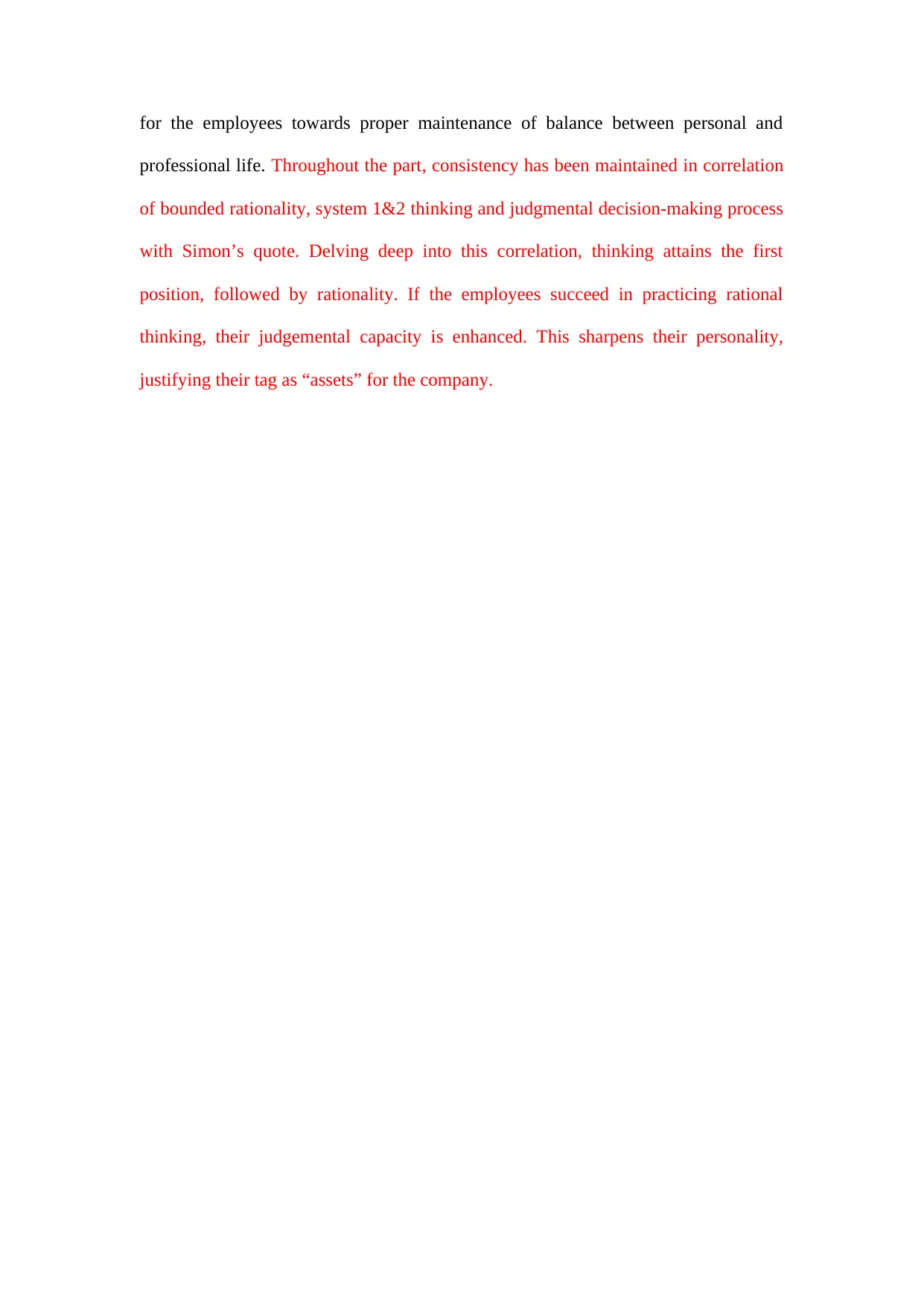
for the employees towards proper maintenance of balance between personal and
professional life. Throughout the part, consistency has been maintained in correlation
of bounded rationality, system 1&2 thinking and judgmental decision-making process
with Simon’s quote. Delving deep into this correlation, thinking attains the first
position, followed by rationality. If the employees succeed in practicing rational
thinking, their judgemental capacity is enhanced. This sharpens their personality,
justifying their tag as “assets” for the company.
professional life. Throughout the part, consistency has been maintained in correlation
of bounded rationality, system 1&2 thinking and judgmental decision-making process
with Simon’s quote. Delving deep into this correlation, thinking attains the first
position, followed by rationality. If the employees succeed in practicing rational
thinking, their judgemental capacity is enhanced. This sharpens their personality,
justifying their tag as “assets” for the company.
⊘ This is a preview!⊘
Do you want full access?
Subscribe today to unlock all pages.

Trusted by 1+ million students worldwide
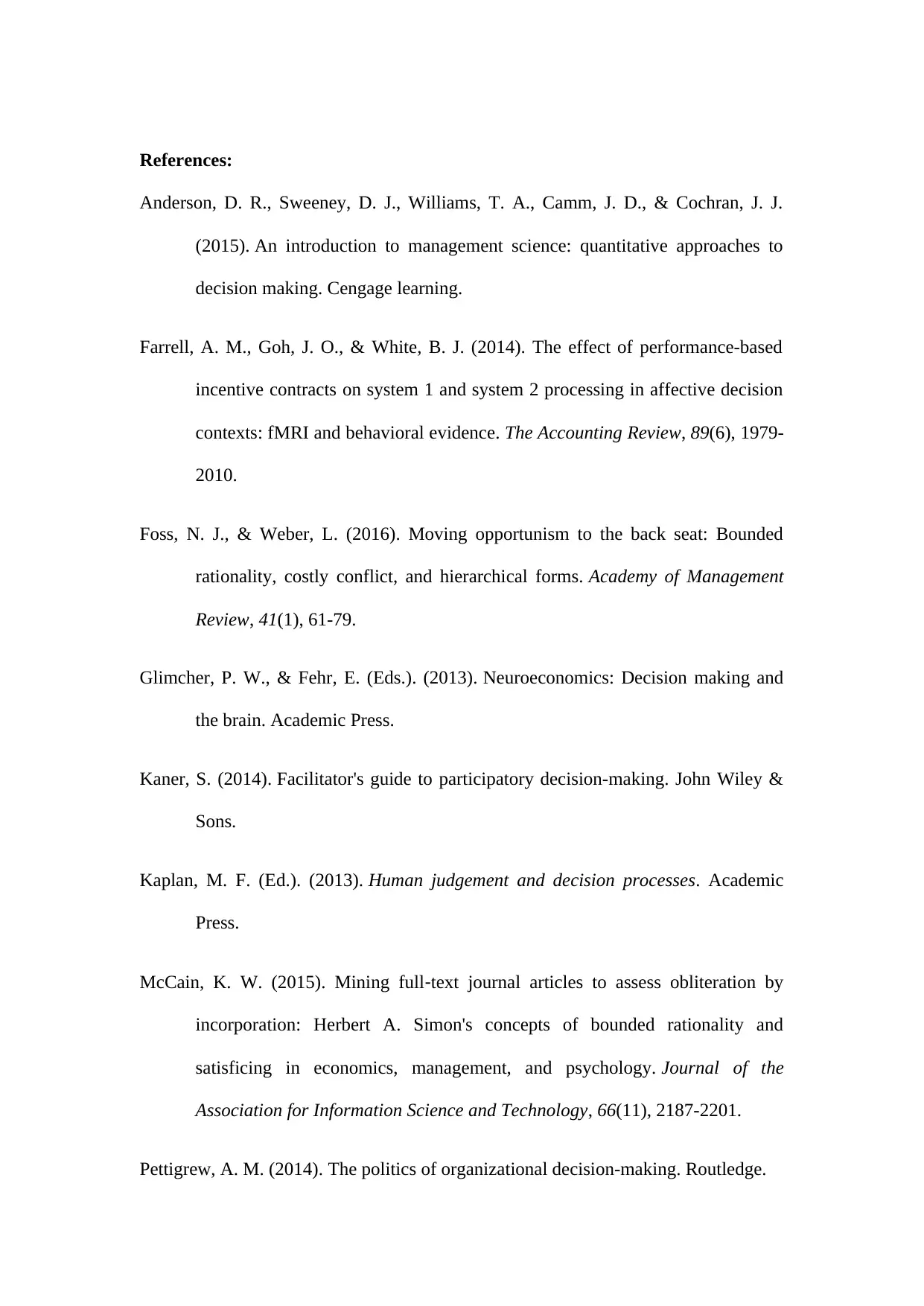
References:
Anderson, D. R., Sweeney, D. J., Williams, T. A., Camm, J. D., & Cochran, J. J.
(2015). An introduction to management science: quantitative approaches to
decision making. Cengage learning.
Farrell, A. M., Goh, J. O., & White, B. J. (2014). The effect of performance-based
incentive contracts on system 1 and system 2 processing in affective decision
contexts: fMRI and behavioral evidence. The Accounting Review, 89(6), 1979-
2010.
Foss, N. J., & Weber, L. (2016). Moving opportunism to the back seat: Bounded
rationality, costly conflict, and hierarchical forms. Academy of Management
Review, 41(1), 61-79.
Glimcher, P. W., & Fehr, E. (Eds.). (2013). Neuroeconomics: Decision making and
the brain. Academic Press.
Kaner, S. (2014). Facilitator's guide to participatory decision-making. John Wiley &
Sons.
Kaplan, M. F. (Ed.). (2013). Human judgement and decision processes. Academic
Press.
McCain, K. W. (2015). Mining full‐text journal articles to assess obliteration by
incorporation: Herbert A. Simon's concepts of bounded rationality and
satisficing in economics, management, and psychology. Journal of the
Association for Information Science and Technology, 66(11), 2187-2201.
Pettigrew, A. M. (2014). The politics of organizational decision-making. Routledge.
Anderson, D. R., Sweeney, D. J., Williams, T. A., Camm, J. D., & Cochran, J. J.
(2015). An introduction to management science: quantitative approaches to
decision making. Cengage learning.
Farrell, A. M., Goh, J. O., & White, B. J. (2014). The effect of performance-based
incentive contracts on system 1 and system 2 processing in affective decision
contexts: fMRI and behavioral evidence. The Accounting Review, 89(6), 1979-
2010.
Foss, N. J., & Weber, L. (2016). Moving opportunism to the back seat: Bounded
rationality, costly conflict, and hierarchical forms. Academy of Management
Review, 41(1), 61-79.
Glimcher, P. W., & Fehr, E. (Eds.). (2013). Neuroeconomics: Decision making and
the brain. Academic Press.
Kaner, S. (2014). Facilitator's guide to participatory decision-making. John Wiley &
Sons.
Kaplan, M. F. (Ed.). (2013). Human judgement and decision processes. Academic
Press.
McCain, K. W. (2015). Mining full‐text journal articles to assess obliteration by
incorporation: Herbert A. Simon's concepts of bounded rationality and
satisficing in economics, management, and psychology. Journal of the
Association for Information Science and Technology, 66(11), 2187-2201.
Pettigrew, A. M. (2014). The politics of organizational decision-making. Routledge.
Paraphrase This Document
Need a fresh take? Get an instant paraphrase of this document with our AI Paraphraser
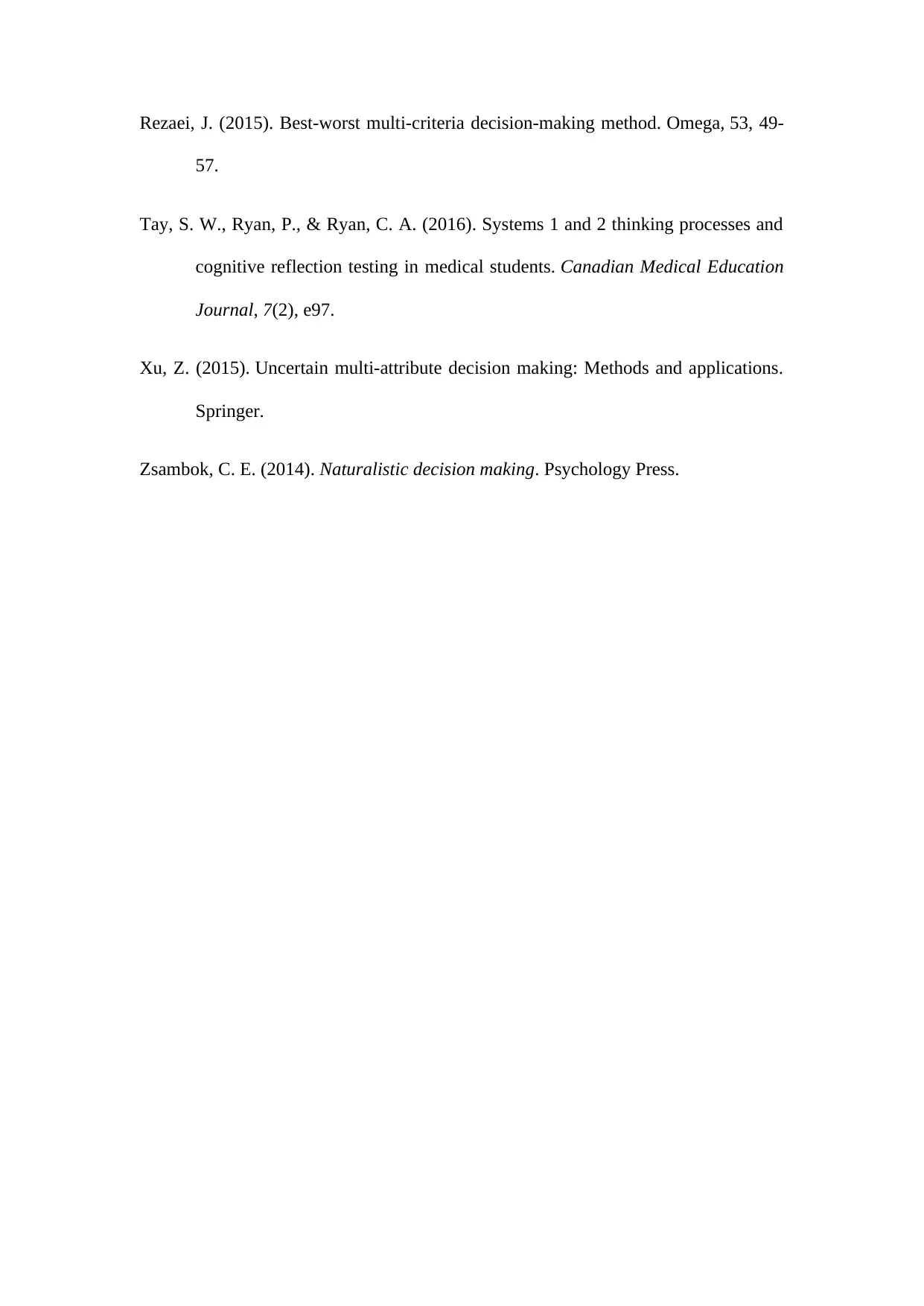
Rezaei, J. (2015). Best-worst multi-criteria decision-making method. Omega, 53, 49-
57.
Tay, S. W., Ryan, P., & Ryan, C. A. (2016). Systems 1 and 2 thinking processes and
cognitive reflection testing in medical students. Canadian Medical Education
Journal, 7(2), e97.
Xu, Z. (2015). Uncertain multi-attribute decision making: Methods and applications.
Springer.
Zsambok, C. E. (2014). Naturalistic decision making. Psychology Press.
57.
Tay, S. W., Ryan, P., & Ryan, C. A. (2016). Systems 1 and 2 thinking processes and
cognitive reflection testing in medical students. Canadian Medical Education
Journal, 7(2), e97.
Xu, Z. (2015). Uncertain multi-attribute decision making: Methods and applications.
Springer.
Zsambok, C. E. (2014). Naturalistic decision making. Psychology Press.
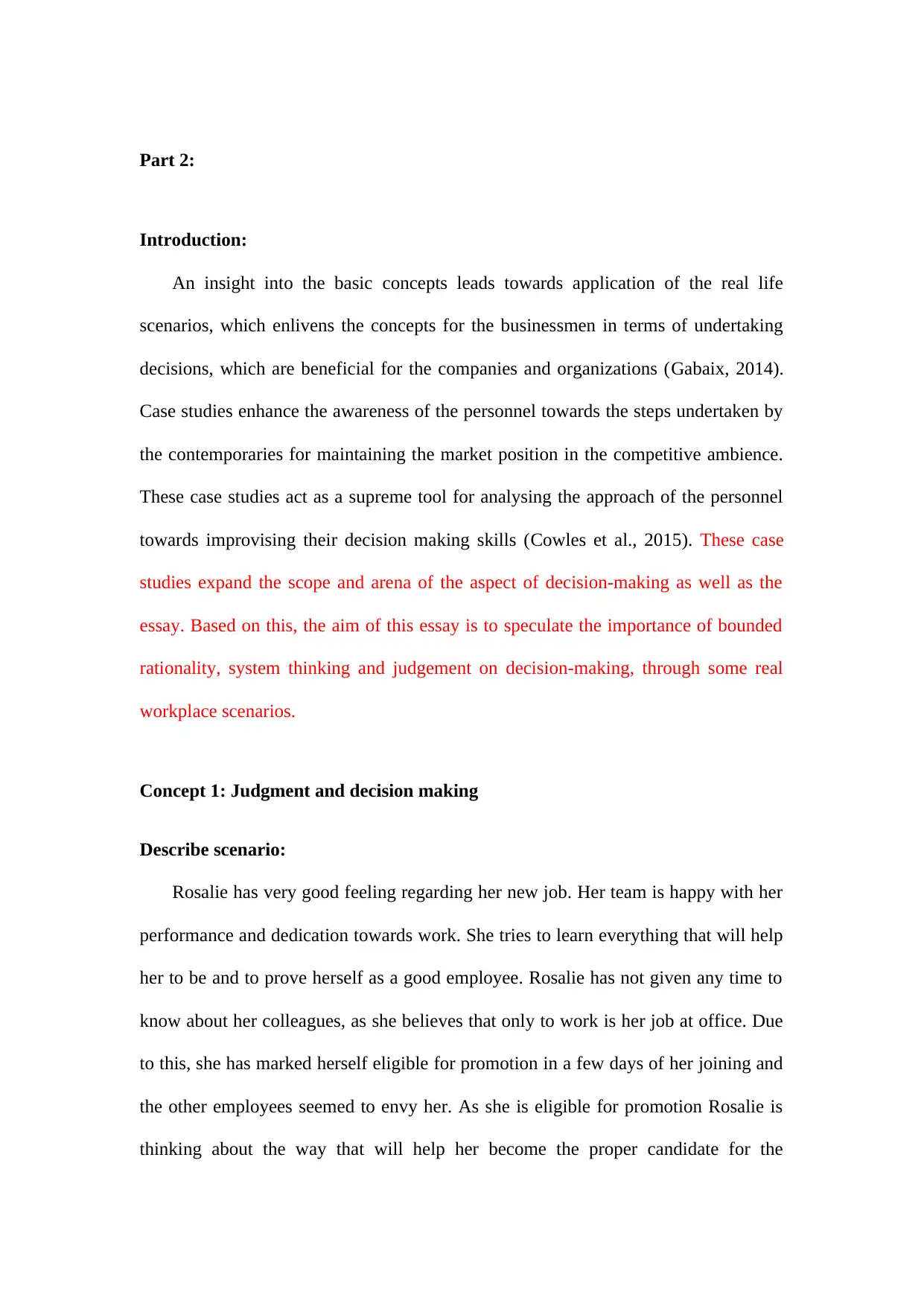
Part 2:
Introduction:
An insight into the basic concepts leads towards application of the real life
scenarios, which enlivens the concepts for the businessmen in terms of undertaking
decisions, which are beneficial for the companies and organizations (Gabaix, 2014).
Case studies enhance the awareness of the personnel towards the steps undertaken by
the contemporaries for maintaining the market position in the competitive ambience.
These case studies act as a supreme tool for analysing the approach of the personnel
towards improvising their decision making skills (Cowles et al., 2015). These case
studies expand the scope and arena of the aspect of decision-making as well as the
essay. Based on this, the aim of this essay is to speculate the importance of bounded
rationality, system thinking and judgement on decision-making, through some real
workplace scenarios.
Concept 1: Judgment and decision making
Describe scenario:
Rosalie has very good feeling regarding her new job. Her team is happy with her
performance and dedication towards work. She tries to learn everything that will help
her to be and to prove herself as a good employee. Rosalie has not given any time to
know about her colleagues, as she believes that only to work is her job at office. Due
to this, she has marked herself eligible for promotion in a few days of her joining and
the other employees seemed to envy her. As she is eligible for promotion Rosalie is
thinking about the way that will help her become the proper candidate for the
Introduction:
An insight into the basic concepts leads towards application of the real life
scenarios, which enlivens the concepts for the businessmen in terms of undertaking
decisions, which are beneficial for the companies and organizations (Gabaix, 2014).
Case studies enhance the awareness of the personnel towards the steps undertaken by
the contemporaries for maintaining the market position in the competitive ambience.
These case studies act as a supreme tool for analysing the approach of the personnel
towards improvising their decision making skills (Cowles et al., 2015). These case
studies expand the scope and arena of the aspect of decision-making as well as the
essay. Based on this, the aim of this essay is to speculate the importance of bounded
rationality, system thinking and judgement on decision-making, through some real
workplace scenarios.
Concept 1: Judgment and decision making
Describe scenario:
Rosalie has very good feeling regarding her new job. Her team is happy with her
performance and dedication towards work. She tries to learn everything that will help
her to be and to prove herself as a good employee. Rosalie has not given any time to
know about her colleagues, as she believes that only to work is her job at office. Due
to this, she has marked herself eligible for promotion in a few days of her joining and
the other employees seemed to envy her. As she is eligible for promotion Rosalie is
thinking about the way that will help her become the proper candidate for the
⊘ This is a preview!⊘
Do you want full access?
Subscribe today to unlock all pages.

Trusted by 1+ million students worldwide
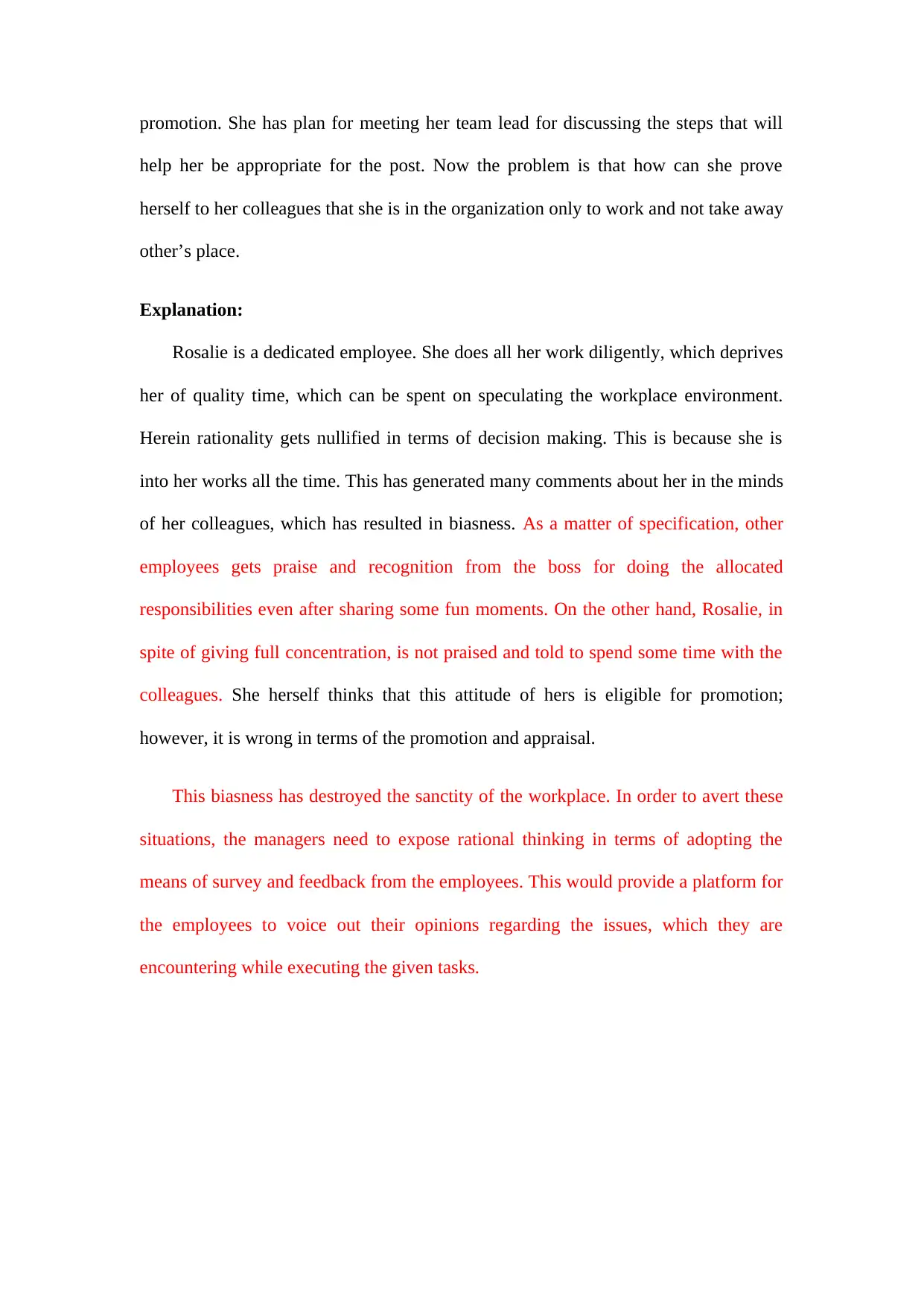
promotion. She has plan for meeting her team lead for discussing the steps that will
help her be appropriate for the post. Now the problem is that how can she prove
herself to her colleagues that she is in the organization only to work and not take away
other’s place.
Explanation:
Rosalie is a dedicated employee. She does all her work diligently, which deprives
her of quality time, which can be spent on speculating the workplace environment.
Herein rationality gets nullified in terms of decision making. This is because she is
into her works all the time. This has generated many comments about her in the minds
of her colleagues, which has resulted in biasness. As a matter of specification, other
employees gets praise and recognition from the boss for doing the allocated
responsibilities even after sharing some fun moments. On the other hand, Rosalie, in
spite of giving full concentration, is not praised and told to spend some time with the
colleagues. She herself thinks that this attitude of hers is eligible for promotion;
however, it is wrong in terms of the promotion and appraisal.
This biasness has destroyed the sanctity of the workplace. In order to avert these
situations, the managers need to expose rational thinking in terms of adopting the
means of survey and feedback from the employees. This would provide a platform for
the employees to voice out their opinions regarding the issues, which they are
encountering while executing the given tasks.
help her be appropriate for the post. Now the problem is that how can she prove
herself to her colleagues that she is in the organization only to work and not take away
other’s place.
Explanation:
Rosalie is a dedicated employee. She does all her work diligently, which deprives
her of quality time, which can be spent on speculating the workplace environment.
Herein rationality gets nullified in terms of decision making. This is because she is
into her works all the time. This has generated many comments about her in the minds
of her colleagues, which has resulted in biasness. As a matter of specification, other
employees gets praise and recognition from the boss for doing the allocated
responsibilities even after sharing some fun moments. On the other hand, Rosalie, in
spite of giving full concentration, is not praised and told to spend some time with the
colleagues. She herself thinks that this attitude of hers is eligible for promotion;
however, it is wrong in terms of the promotion and appraisal.
This biasness has destroyed the sanctity of the workplace. In order to avert these
situations, the managers need to expose rational thinking in terms of adopting the
means of survey and feedback from the employees. This would provide a platform for
the employees to voice out their opinions regarding the issues, which they are
encountering while executing the given tasks.
Paraphrase This Document
Need a fresh take? Get an instant paraphrase of this document with our AI Paraphraser
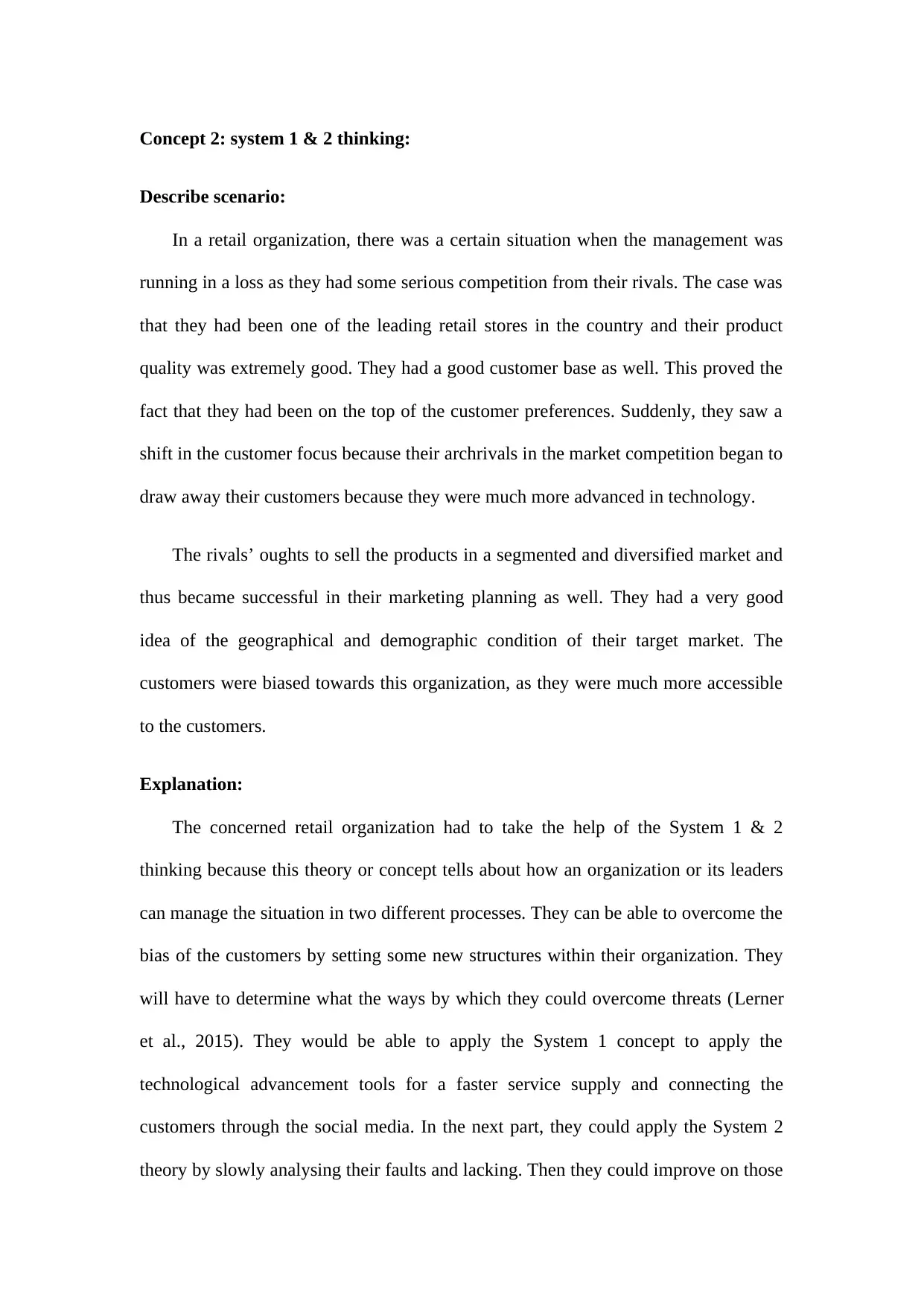
Concept 2: system 1 & 2 thinking:
Describe scenario:
In a retail organization, there was a certain situation when the management was
running in a loss as they had some serious competition from their rivals. The case was
that they had been one of the leading retail stores in the country and their product
quality was extremely good. They had a good customer base as well. This proved the
fact that they had been on the top of the customer preferences. Suddenly, they saw a
shift in the customer focus because their archrivals in the market competition began to
draw away their customers because they were much more advanced in technology.
The rivals’ oughts to sell the products in a segmented and diversified market and
thus became successful in their marketing planning as well. They had a very good
idea of the geographical and demographic condition of their target market. The
customers were biased towards this organization, as they were much more accessible
to the customers.
Explanation:
The concerned retail organization had to take the help of the System 1 & 2
thinking because this theory or concept tells about how an organization or its leaders
can manage the situation in two different processes. They can be able to overcome the
bias of the customers by setting some new structures within their organization. They
will have to determine what the ways by which they could overcome threats (Lerner
et al., 2015). They would be able to apply the System 1 concept to apply the
technological advancement tools for a faster service supply and connecting the
customers through the social media. In the next part, they could apply the System 2
theory by slowly analysing their faults and lacking. Then they could improve on those
Describe scenario:
In a retail organization, there was a certain situation when the management was
running in a loss as they had some serious competition from their rivals. The case was
that they had been one of the leading retail stores in the country and their product
quality was extremely good. They had a good customer base as well. This proved the
fact that they had been on the top of the customer preferences. Suddenly, they saw a
shift in the customer focus because their archrivals in the market competition began to
draw away their customers because they were much more advanced in technology.
The rivals’ oughts to sell the products in a segmented and diversified market and
thus became successful in their marketing planning as well. They had a very good
idea of the geographical and demographic condition of their target market. The
customers were biased towards this organization, as they were much more accessible
to the customers.
Explanation:
The concerned retail organization had to take the help of the System 1 & 2
thinking because this theory or concept tells about how an organization or its leaders
can manage the situation in two different processes. They can be able to overcome the
bias of the customers by setting some new structures within their organization. They
will have to determine what the ways by which they could overcome threats (Lerner
et al., 2015). They would be able to apply the System 1 concept to apply the
technological advancement tools for a faster service supply and connecting the
customers through the social media. In the next part, they could apply the System 2
theory by slowly analysing their faults and lacking. Then they could improve on those
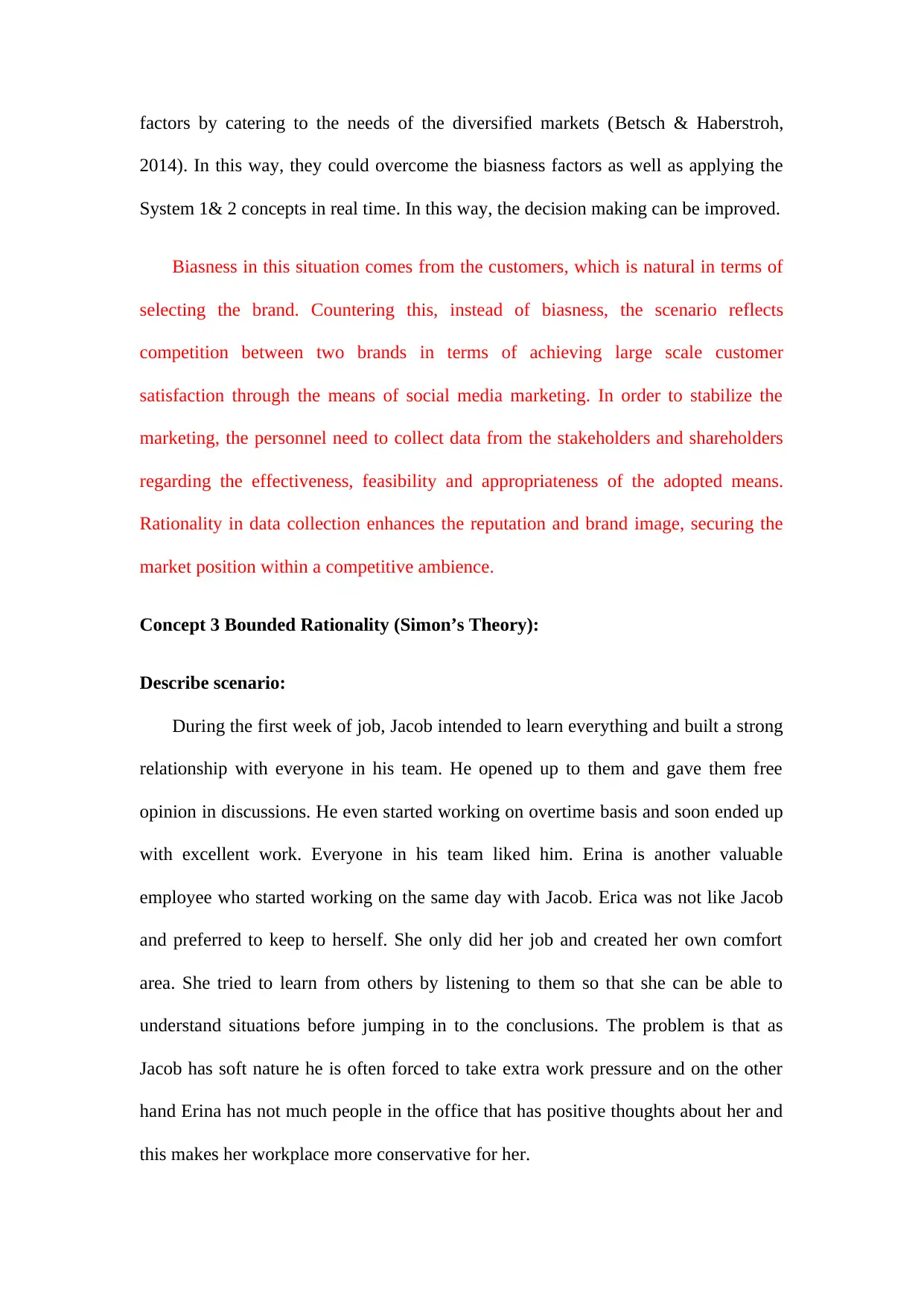
factors by catering to the needs of the diversified markets (Betsch & Haberstroh,
2014). In this way, they could overcome the biasness factors as well as applying the
System 1& 2 concepts in real time. In this way, the decision making can be improved.
Biasness in this situation comes from the customers, which is natural in terms of
selecting the brand. Countering this, instead of biasness, the scenario reflects
competition between two brands in terms of achieving large scale customer
satisfaction through the means of social media marketing. In order to stabilize the
marketing, the personnel need to collect data from the stakeholders and shareholders
regarding the effectiveness, feasibility and appropriateness of the adopted means.
Rationality in data collection enhances the reputation and brand image, securing the
market position within a competitive ambience.
Concept 3 Bounded Rationality (Simon’s Theory):
Describe scenario:
During the first week of job, Jacob intended to learn everything and built a strong
relationship with everyone in his team. He opened up to them and gave them free
opinion in discussions. He even started working on overtime basis and soon ended up
with excellent work. Everyone in his team liked him. Erina is another valuable
employee who started working on the same day with Jacob. Erica was not like Jacob
and preferred to keep to herself. She only did her job and created her own comfort
area. She tried to learn from others by listening to them so that she can be able to
understand situations before jumping in to the conclusions. The problem is that as
Jacob has soft nature he is often forced to take extra work pressure and on the other
hand Erina has not much people in the office that has positive thoughts about her and
this makes her workplace more conservative for her.
2014). In this way, they could overcome the biasness factors as well as applying the
System 1& 2 concepts in real time. In this way, the decision making can be improved.
Biasness in this situation comes from the customers, which is natural in terms of
selecting the brand. Countering this, instead of biasness, the scenario reflects
competition between two brands in terms of achieving large scale customer
satisfaction through the means of social media marketing. In order to stabilize the
marketing, the personnel need to collect data from the stakeholders and shareholders
regarding the effectiveness, feasibility and appropriateness of the adopted means.
Rationality in data collection enhances the reputation and brand image, securing the
market position within a competitive ambience.
Concept 3 Bounded Rationality (Simon’s Theory):
Describe scenario:
During the first week of job, Jacob intended to learn everything and built a strong
relationship with everyone in his team. He opened up to them and gave them free
opinion in discussions. He even started working on overtime basis and soon ended up
with excellent work. Everyone in his team liked him. Erina is another valuable
employee who started working on the same day with Jacob. Erica was not like Jacob
and preferred to keep to herself. She only did her job and created her own comfort
area. She tried to learn from others by listening to them so that she can be able to
understand situations before jumping in to the conclusions. The problem is that as
Jacob has soft nature he is often forced to take extra work pressure and on the other
hand Erina has not much people in the office that has positive thoughts about her and
this makes her workplace more conservative for her.
⊘ This is a preview!⊘
Do you want full access?
Subscribe today to unlock all pages.

Trusted by 1+ million students worldwide
1 out of 17
Related Documents
Your All-in-One AI-Powered Toolkit for Academic Success.
+13062052269
info@desklib.com
Available 24*7 on WhatsApp / Email
![[object Object]](/_next/static/media/star-bottom.7253800d.svg)
Unlock your academic potential
Copyright © 2020–2025 A2Z Services. All Rights Reserved. Developed and managed by ZUCOL.





